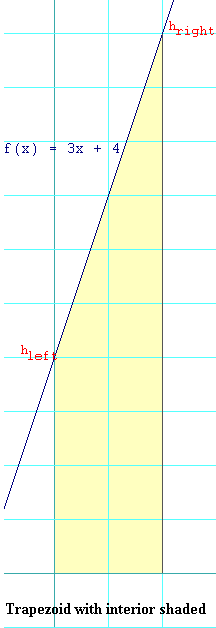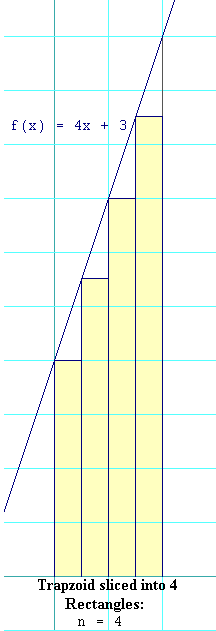


See the figure on the right to visualize what area this problem is dealing with. Notice that the lower base of the trapezoid in the figure is length 2 (scroll down a bit to see the bottom of the figure if you need to). If you divide something of length 2 into n sections, each section will be of length 2/n.
We are finding at what x the left-hand edge of the kth
slice is.
The first slice has its left-hand edge at the origin, or at
You know that the x for the left-hand edge of the kth
rectangle is 2(k-1)/n. So put that as x into
hk = f(x) = f(2(k-1)/n) = (6(k-1)/n) + 4

The figure on the right shows the trapezoid sliced into 4 strips
(that is,
Ak = (2/n) ( (6(k-1)/n) + 4 )
= (12(k-1)/n2) + (8/n)
You have an expression for the area of the kth rectangle, Ak, from step 4. And you know that k ranges from 1 to n. So the sum over Ak is
n
Atotal = å Ak
k=1
and when you substitute the expression from step 4 in for Ak,
you get
n
Atotal = å (12(k-1)/n2) + (8/n)
k=1
From step 5, the thing you have in the summation is the sum of 12(k-1)/n2 and 8/n. So you just break it into two summations using two sigma-expressions:
n n
Atotal = å 12(k-1)/n2 + å 8/n
k=1 k=1
From step 6, you had the sum over k of 12(k-1)/n2, and the sum over k of 8/n. In the case of the first expression, the factor that is constant with respect to k is 12/n2. For the second one, the whole expression, 8/n, is constant with respect to k, so it all comes out. This gives you
n n
Atotal = (12/n2) å k-1 + (8/n) å 1
k=1 k=1
The first sum from step 7 is asking you to take the sum of the integers from
zero to n-1. Recall from equation 10.1-7a
that this sum gives you
Atotal = (12/n2)(n2/2 - n/2) + (8/n)(n)
= 6 - 6/n + 8
= 14 - 6/n
From step 8 you have that the approximate area is
I'd like you to try this problem again on your own, but instead of taking
the area bounded on the right by
email me at hahn@netsrq.com